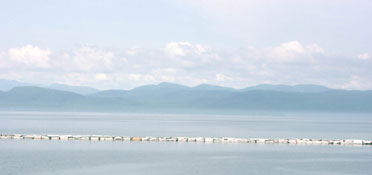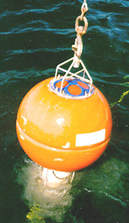 |
||||
Hydrodynamic Studies on Lake Champlain
Michael McCormick and Gary Fahnenstiel
Collaborators
Tom Manley, Middlebury College (Middlebury
College web site)
Jean Claude Gascard, Laboratoire D'Oceanologie Dynamic et de Climatologie,
University of Paris (University of
Paris web site)
Ken Hunkins, Columbia University (Columbia
University web site)

Project rationale: Hydrodynamic studies have been underway on Lake Champlain since 1990 and is being expanded to include novel lagrangian experiments, modeling and lower food web work. Dr. Fahnenstiel will assume responsibilities for any lower food web work and its potential application to water quality modeling.
The mean circulation patterns of Lake Champlain have been very difficult to obtain using long-term Eulerian measurement techniques due to the large oscillatory motions created by the internal seiche. A pilot program recently began on Lake Champlain involving the use of deep-ocean neutrally-buoyant free-drifter technology known as RAFOS.
Program Plans
The program consists of two field efforts. First, an acoustic propagation phase that would provide results as to whether or not Lake Champlain would be capable of supporting an acoustic net that could be used for tracking underwater drifters. The use of underwater acoustics is essential to the success of the program in that the underwater drifters have to be able to detect and verify the encoded signals emitted by the various sound sources moored at precise locations within the lake. The location of the drifter over time can then be determined using triangulation techniques knowing the distances from the various sound sources. The experiments are designed around the standard deep-ocean equipment operating at 1560 HZ. The drifters are of a new design "Lake Champlain Profiler" based upon the WHOI "SOLO" float and built by Pierre Tillier (Seascan, Falmouth Massachusetts) A couple of these RAFOS drifters would be tested in a free drifting period to fully evaluate the experimental design. Once the testing phase is completed the second phase will consist of large scale experiments involving fixed current meter moorings, RAFOS drifters and GLERL satellite-tracked surface drifters. The RAFOS and surface drifters will allow us to estimate the lagrangian flow field in both the surface mixed layer and in the hypolimnion as well.
2006 Plans
Dima Beletsky (CILER) will be doing three-dimensional hydrodynamic modeling of Lake Champlain (CILER web site).
2005 Accomplishments
Several meetings were held to help refocus the Lake Champlain research priorities. A Cooperative Institute for Limnoloigcal and Ecological Research proposal was written to cover both the atmospheric and hydrodynamic research being conducted on Lake Champlain under the direction of the research consortium, ARL and GLERL. The Lagrangian data from 2004 have been edited and the subsequent analyses have begun.
Program History and Past Accomplishments
The major emphasis for 2004 was conducting hydrodynamic field studies.The field program was successful with fixed moorings deployed in the northeast arm of the lake. In addition, the Lagrangian portion of the field efforts used surface and subsurface (RAFOS) drifters during July and August.
In 2003 9 moorings were deployed in Lake Champlain in June including temperature data loggers, ADCPs and sound sources for deep water RAFOS experiments. Drifter experiments were conducted in Lake Champlain in July. All moorings were recovered and RAFOS experiments completed in August.
Prior to GLERL principle investigator Michael McCormick's involvement two now retired investigators James Saylor and Gerald Miller served as the GLERL's Lake Champlain research program leaders.
GLERL initiated a long-term measurement program to study currents and water temperature fluctuations in the deep, main basin of Lake Champlain using funds first provided by the FY1992 Congressional Add-On. The main lake basin measurement program continued intermittently through FY1997. Additional studies of water mass exchanges between the main lake and one of its major embayments have also been made. In FY1994, the measurement program concentrated on the dynamics of the main lake's north end, where earlier observations showed high speed bottom currents and bottom sediment resuspension in water as deep as 100 m. In FY 1997, resuspension of bottom sediments in the lake's shallow south end was investigated. GLERL has used over one-half of the Congressional Add-Ons funding this research to support collaborators.
Lake Champlain is mostly ice covered in winter. Current measurements made during one-winter season (1992-93) revealed relatively quiescent flow conditions. Currents are stronger during the spring and fall periods of isothermal water, but attain their highest speeds during summer and fall when the water is strongly density-stratified. Oriented in a north-south direction, the long, deep, and narrow stratified lake is very sensitive to winds from these directions that funnel through the Champlain Valley. The lowest mode internal seiche of the main lake basin has a period close to 4 days in length during late summer. Wind forcing has considerable energy near the same period. The main basin internal seiches attain very large amplitudes under near-resonant wind forcing, wave heights as large as 40 m have been measured. Large quantities of water, both above and below the thermocline, slosh back and forth along the long axis of the lake. Water current speeds driven by the seiche escalate to high speeds (40 cm/sec near bottom speeds have been measured), sufficient to erode and transport bottom sediments that in many areas are contaminated with toxins.
 A major observational study of currents
and water mass exchange processes within the Shelburne and Burlington
Bay complex was performed from September 1999 to August 2000. A large
number of subsurface moorings with attached Acoustic Doppler Current Profilers
and thermistor strings were deployed in the Bays and water stage and temperature
measuring instruments were placed around the perimeters. Early analyses
of the data have shown surface wave oscillations with periods of nearly
30 minutes driving currents into and out of Shelburne Bay and also large
water stage oscillations of nearly 3.5 days in period driving mass exchanges.
The shorter period waves have been modeled as a surface standing wave
confined to Shelburne Bay and the longer period wave is apparently a barotropic
response of Shelburne bay to the baroclinic 1st-mode longitudinal internal
seiche of Lake Champlain. A diurnal thermocline oscillation within the
bay complex was also observed but has not been linked with a corresponding
lake surface oscillation.
A major observational study of currents
and water mass exchange processes within the Shelburne and Burlington
Bay complex was performed from September 1999 to August 2000. A large
number of subsurface moorings with attached Acoustic Doppler Current Profilers
and thermistor strings were deployed in the Bays and water stage and temperature
measuring instruments were placed around the perimeters. Early analyses
of the data have shown surface wave oscillations with periods of nearly
30 minutes driving currents into and out of Shelburne Bay and also large
water stage oscillations of nearly 3.5 days in period driving mass exchanges.
The shorter period waves have been modeled as a surface standing wave
confined to Shelburne Bay and the longer period wave is apparently a barotropic
response of Shelburne bay to the baroclinic 1st-mode longitudinal internal
seiche of Lake Champlain. A diurnal thermocline oscillation within the
bay complex was also observed but has not been linked with a corresponding
lake surface oscillation.
A Lagrangian drifters (RAFOS) program commenced within the main lake basin near the end of the Shelburne Bay field program (late May - early June 2000). USGS, the Lintilhac Foundation, Middlebury College, and NOAA shared funding for this program. The principle investigators were Tom Manley (Middlebury College) and Jean-Claude Gascard (Laboratoire D'Oceanolgie Dynamique et de Climatologie, Paris, France). The intent of the study was to determine the feasibility of tracking subsurface drifters using acoustic transponders and receivers throughout the basin to measure Lagrangian currents. Using acoustic travel times between a fixed array of moored stations and freely floating subsurface floats, the floats positions were computed by triangulation.
Analyses of a 3-year-long Lake Champlain data set for evidence of the occurrence of gravity currents and internal bores and surges have been completed. The high-velocity currents that these waveforms generate are important causes of the observed resuspension of bottom sediments in the deep water of the lake basin. In winter, the current velocities in the deepest parts of the lake basin are slight beneath a nearly completely frozen water surface. With summer warming and density stratification, the kinetic energy of the currents increases. Wind stress efficiently transports the less dense surface layers toward one end of the lake basin or the other. Relaxation of the wind forcing permits internal waves to propagate, the wave characteristics are determined by several variables relating to basin dimensions, shape, the intensity of the stratification and the magnitude of the initial thermocline displacement. Large amplitude internal waves (wave heights as large as 30 to 40 meters) drive strong currents throughout the entire water column. Internal bore and surge waveforms also drive currents that are strong enough to resuspend bottom sediments. Results of the studies have been reported in 1999 in a series of papers appearing in the American Geophysical Union Water Resources Monograph 14, entitled "Lake Champlain in Transition: From Research Toward Restoration", edited by T.O. and P.L. Manley.
An intensive study of water circulation and water volume renewal within the Shelburne and Burlington Bay complex was initiated with the installation of an array of Acoustic Doppler Current Profilers and water temperature measuring thermistor chains in September 1999. This was a cooperative study undertaken by GLERL, Middlebury College, University of Vermont, and Lamont-Doherty Earth Observatory researchers and the field studies continued until August 2000. Within the region of study numerous potable water intakes and sewage outfalls exist and there was a demonstrated need for improved water movements information. Conclusions from these studies were reported at a Lake Champlain research results and management conference in May 2002 and published in a 2nd American Geophysical Union Water Resources Monograph.
Products
Beletsky, D., J.H. Saylor, and D.J. Schwab. Mean Circulation in the Great Lakes. J. Great Lakes Res. 25(1):78-93 (1999).
Manley, P., T.O. Manley, K. Hunkins, and J. Saylor. Sediment deposition and resuspension in Lake Champlain. Water Resources Monograph No. 14, American Geophysical Union, pp. 157-181 (1999).
Manley, T.O., K. Hunkins, J. Saylor, G. Miller and P. Manley. Aspects of summertime and wintertime hydrodynamics of Lake Champlain. Water Resources Monograph No. 14, American Geophysical Union, pp. 67-115 (1999).
Miller, G.S., J.H. Saylor, and M.J. McCormick. Detecting storm-generated suspended materials in Lake Michigan using ADCP echo intensities. Proceedings of the IEEE Sixth Working Conference on Current Measurement, IEEE, March 11-13, 264-268 (1999).
Saylor, J., G. Miller, K. Hunkins, T.O. Manley, and P. Manley. Gravity currents and internal bores in Lake Champlain. Water Resources Monograph No. 14, American Geophysical Union, pp. 135-155 (1999).
Hunkins, K., T.O. Manley, P. Manley, and J. Saylor. Numerical studies of the 4-day oscillation in Lake Champlain. Journal of Geophysical Research 103(C9):18,425-18,436 (1998).
Hunkins, K. D. Mendelsohn, and T. Isaji. Numerical hydrodynamic models of Lake Champlain. Water Resources Monograph No. 14, American Geophysical Union, pp. 117-134 (1999).
Marinov, I. Wind-generated oscillations in Lake Champlain. Senior thesis, Middlebury College, Middlebury, Vermont (1998).
Mendelsohn, D.L., T. Isaji, and H. Rines. Hydrodynamic and water quality modeling of Lake Champlain. Final Report prepared for the Lake Champlain Management Conference, c/o Water Management Division, U.S. EPA, Region 1, JFK Building, Boston, MA 02203 (1995).
Prigo, R.B., T.O. Manley, and B.S.H. Connell, Linear, one-dimensional models of the surface and internal standing waves for a long and narrow lake. Am. J. Phys., 64(3):288-300 (1996).
Milestones
Milestone-01-3-2: Complete data collections describing currents and water circulation during summer and winter conditions in Burlington and Shelburne Bays, Lake Champlain.
Last updated: 2005-10-21 mbl

